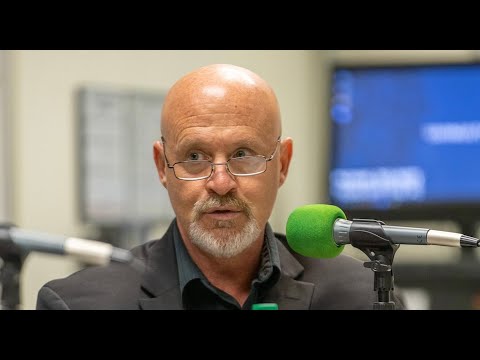Tom O’Neill-Thorne knew the exact moment he wanted to become an athlete. He was three years old and watching the 2000 Sydney Olympics on television.
Key points:
- The AIS is using Formula 1 race car technology on some seats of wheelchair basketballers for the Paralympics
- The prepreg carbon-fibre seats are designed to increase speed and agility
- Paralympian Tom O’Neill-Thorne will use one of the new seats in Tokyo, which he and teammates have nicknamed “The Bucket”
Soon after that, he began trying out different sports.
“I wanted to play cricket for Australia, which is a little hard in a wheelchair,” he says.
“My parents were very supportive of me playing different sports, so I played cricket with able-bodied kids, I played soccer.”
But he knew he found his destiny while watching wheelchair basketball for the first time at the 2007 Arafura Games in Darwin, a mixed international competition for able-bodied and disabled athletes.
“I just fell in love with the sport,” O’Neill-Thorne smiles.
“It’s such an exciting sport to watch and even more exciting to play.”
Now, O’Neill-Thorne is preparing to compete at his second Paralympic Games with Australia’s men’s wheelchair basketball team, the Rollers.
And the 24-year-old is feeling supercharged thanks to the extra firepower of Formula 1 race car technology added to his wheelchair seat.
Supplied: AIS
)Paralympics Australia and Basketball Australia have been working with Australian Institute of Sport (AIS) engineers to provide some athletes in the Rollers squad with custom-made carbon-fibre seats.
AIS senior engineer Matt Crawford says the seats are moulded to the individual’s body shape, using material identical to that used in the bodies of F1 race cars.
“We use prepreg (pre-impregnated) carbon-fibre — the same technology that you’ll find in a Formula 1 car, an America’s Cup boat or aerospace,” Crawford says.
“It has the highest strength-to-weight ratio and the seats tend to be very light.”
It’s also designed to increase speed and agility.
The latest in cutting-edge technology
Several members of the AIS team, including Crawford, have a background in motorsport.
He says the team is combining its knowledge of sports car racing with the latest cutting-edge technology.
The lighter weight not only provides better support and agility but an improved performance.
“There have been quite decent improvements in push performance over 10 metres and agility,” Crawford says.
O’Neill-Thorne believes it will change the game over the next five to 10 years.
“Especially in our sport, it’s fast-reaction speed, with quick turns and movements.
Supplied: AIS
)“To be able to get even point-zero of a second faster at something would be game-changing,” he says.
O’Neill-Thorne says he feels lucky to be among the first basketballers to benefit from the new technology, along with fellow Rollers Jannik Blair and Tristan Knowles.
“We’ve got a nickname, it’s called ‘The Bucket’, because you’re basically sitting inside a really expensive, tailor-made bucket seat of carbon fibre,” O’Neill-Thorne laughs.
“To see where it can go from here will be really interesting.
Evolution of work makes chair and athlete one
Crawford describes the collaboration between the AIS and Paralympics Australia as an evolution of work done over many years.
Crawford also designed the wheelchair of tennis superstar Dylan Alcott, who recently won his third consecutive French Open title in the men’s quad wheelchair singles event and 13th overall grand slam singles crown.
“Dylan Alcott was a successful athlete before we started these projects, but I think we’ve really helped boost his performance,” Crawford says.
O’Neill-Thorne has also seen how far wheelchair sports have progressed over the last decade.
From borrowed chair to champion Roller
O’Neill-Thorne was born with arthrogryposis multiplex congenita, a condition affecting the mobility in his legs.
He grew up in Darwin and began playing wheelchair basketball from the age of nine, using a borrowed chair that was older than him.
Supplied: Tom O’Neill-Thorne
)“My first chair was donated to me by Melissa Dunn, a silver medallist at the Sydney Paralympic Games,” O’Neill-Thorne recalls.
“The chair was older than me and wasn’t customised.
“It didn’t have many straps or sideguards and we had to adjust the wheels to fit me in it,” he says.
But O’Neill-Thorne’s talent as an elite athlete was already showing.
Loading
At the age of 17, he became the youngest Roller to ever compete in a world championship.
He represented Australia at the 2014 IWBF World Wheelchair Basketball Championship in South Korea, where the Rollers won a second consecutive world title.
Two years later, O’Neill-Thorne made his Paralympic debut at the 2016 Rio Games, where Australia was eliminated from gold medal contention with a loss to Great Britain in the quarter finals.
The result was a disappointing one for the Rollers, who in London 2012 fell short of a gold medal but took silver.
Australia went on to secure a bronze medal at the 2018 Wheelchair Basketball World Cup and O’Neill-Thorne says he’s feeling optimistic heading into Tokyo.
“I think Australia is set up so well for the Tokyo Paralympics.
“Hopefully the chair makes me a little faster and I look good doing it,” he adds with a cheeky grin.






